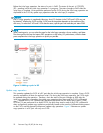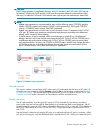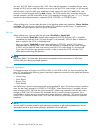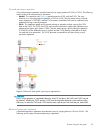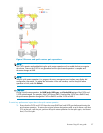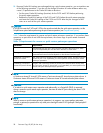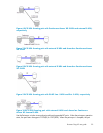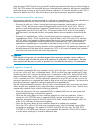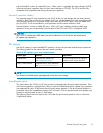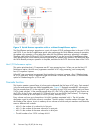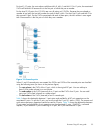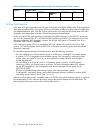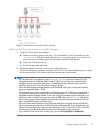
status changes to PAIR. The disk array resumes BC update copy operations after the pair status changes to
PAIR. The P-VOL remains fully accessible during a normal pairresync operation, but becomes inaccessible
to all hosts during a reverse or quick restore pairresync operation. This ensures that data on the P-VOL is
identical to data on the S-VOL when the reverse or quick restore pairresync operation completes.
Pair status and time required for pairresync
The pairresync operation can be performed on a split pair or suspended pair. This section describes the
relationship
between the pair status and the time required for pairresync operations.
• Pairresync for split pair. When a normal/quick pairresync operation is performed on a split pair
(status = PSUS), the disk array copies all flagged tracks from the P-VOL to the S-VOL. When a
reverse or quick restore pairresync operation is performed on a split pair, the disk array copies all
flagged trac
ks from the S-VOL to the P-VOL. This ensures that the P-VOL and S-VOL are properly
resynchronized in the desired direction, and greatly reduces the time needed to resynchronize the
pair.
• Pairresync
for suspended pair. When a normal/quick pairresync operation is performed on a
suspended pair (status = PSUE), the disk array copies all data on the P-VOL to the S-VOL, because
all P-VOL tracks were flagged as difference data when the pair was suspended. Reverse and quick
restore pairresync operations cannot be performed on suspended pairs. The normal pairresync
operation
for suspended pairs is equivalent to and takes as long as the BC initial copy operation.
If you perf
orm the quick pairresync operation on the suspended pairs, the update copy operation will
be performed and all the data will be copied to the S-VOL. In this case, the update copy operation
maytakemuchmoretimethantheinitialcopyoperation.
CAUTION:
When resy
nchronizing pairs, you can select the pace for the pairresync operation: slower, medium, or
faster. T
he slower pace minimizes the impact of BC operations on subsystem I/O performance. The faster
pace resynchronizes the pairs as quickly as possible, but it may affect the disk array's I/O performance.
Pairsplit-E operation (suspend)
This operation suspends the BC copy operations to the S-VOL of the pair. You can suspend a BC pair
at any time. When a BC pair is suspended (status = PSUE), the disk array stops performing BC copy
operations to the S-VOL, continues accepting write I/O operations to the P-VOL, and marks all P-VOL
tracks as difference data. When a pairresync operation is performed on a suspended pair, the entire
P-VOL is copied to the S-VOL. While the pairresync operation for a split BC pair can be very fast, the
pairresync operation for a suspended pair takes as long as the initial copy operation. The reverse and
quick restore pairresync operations cannot be performed on suspended pairs.
ThediskarrayautomaticallysuspendsaBCpairwhenitcannotkeepthepairmirroredforanyreason.
When the disk array suspends a pair, sense information is generated to notify the host. The disk array
automatically suspends a pair under the following conditions:
• When the volume pair has been suspended (PSUE) or deleted (SMPL) from an open system host
using the RAID Manager command line interface.
• When the disk array detects an error condition related to an initial copy operation. When a
volume pair with COPY(PD) status is suspended (PSUE), the disk array aborts the initial copy
operation, changes the status of the P-VOL and S-VOL to SMPL, accepts all subsequent write I/Os
to the S-VOL, and does not keep track of updates.
• When the disk array detects an error condition related to an update copy operation.
• When the P-VOL and/or S-VOL track map in shared memory is lost (for example, due to offline
microprogram exchange). This applies to COPY(SP) and PSUS(SP) pairs only. For PAIR, PSUS,
COPY(RS),orCOPY(RS-R)pairs,thepairisnotsuspended,buttheentireP-VOL(S-VOLforreverse
or quick restore pairresync) is marked as difference data.
30
Business Copy XP (BC) for the Array



